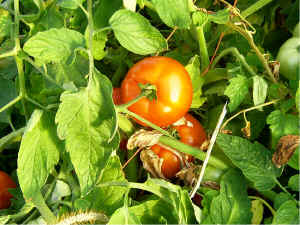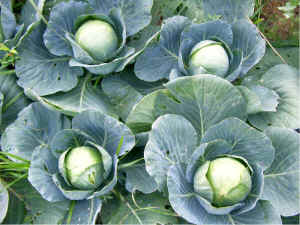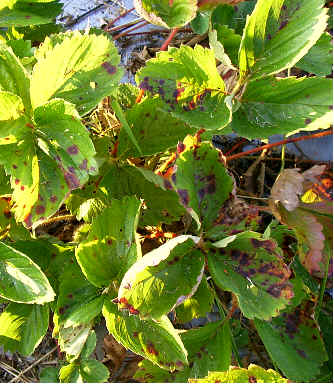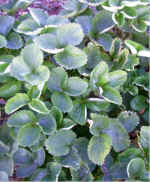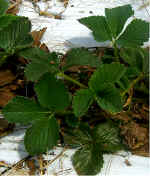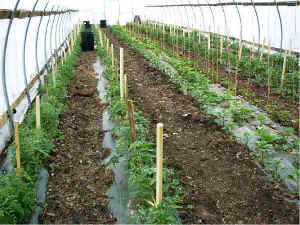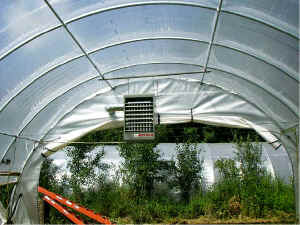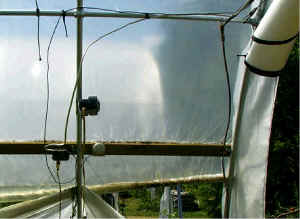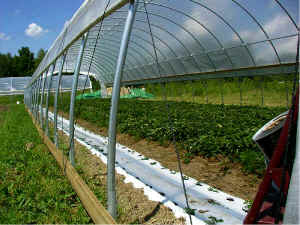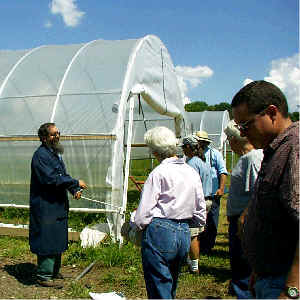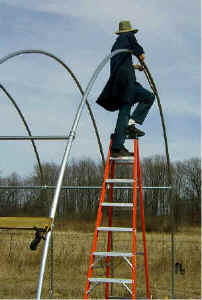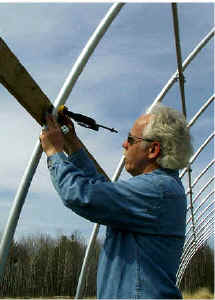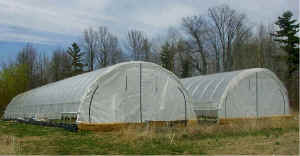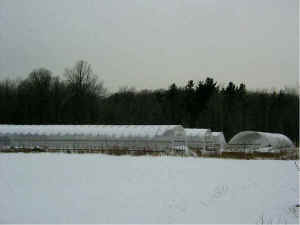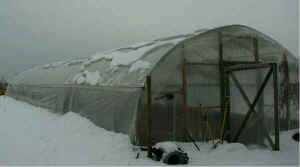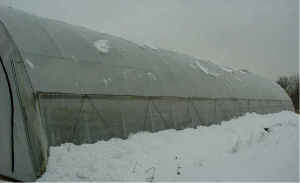High Tunnel Agriculture
(Notes and slides from Dan Mielke's presentation)
High
tunnels may not give you more hours in a day but they will give you months of
extra hours in a growing season.
Neither
rain, sleet, nor snow shall prevent you from tending your appointed ground.
The
high tunnel reduces your work, increases your harvest, helps you beat out your
competition, and gives you the time to enjoy the work you love.
1.
Earlier Yields
Higher Yields
No Cracks
No Blight
No Storm Damage
NO COMPETITION!!!
Can it get any better?
~
2.
20’X 96’ tunnel
4 rows of tomatoes
2 rows of peppers
1 row of cucumbers
Production
4,500 lbs of tomatoes
13 bushel of peppers
300 lbs of cucumbers before squash beetles killed them
Cost of tunnel was 2,000 dollars
Sales were over 5,000 dollars
While the insects did affect the cabbage the damage was minimal.
Heads were solid and productive
While cabbage is not a money maker it makes a nice
addition to our early market offerings.
~
4.

2003 Crop
Berries came late.
Frost killed crop outside.
Inside the tunnels we picked until the end
of October when we let them freeze.
Temporary heat can help carry you
over a brief cold spell.
Extended heating is not practical.
~
5.
Notice the health of the leaves.
These pictures were taken on the same day, about 2 weeks after
berry production was finished.
~
6.
Berries outside without any mulch or cover were still dormant.
~
7.
Tunnel berries shown
Three varieties were grown in the test plots
Berries
Were earlier
Were bigger
Were sweeter
Had a greater yield
Had less pest damage
Had less rain damage
~
8.
Inside View of tunnel - pictured:
Determinant Tomatoes
Peppers
Parthenocarpic cucumbers
All crops were planted directly in the soil through plastic mulch with drip tape.
Leaf mulch was used between rows
to suppress weeds.
~
9.
As foliage increases attention must be given to potential insect infestations and possible diseases.
Air flow is extremely important!
Tunnel should be set up so as to insure a good airflow.
Avoid setting up your tunnels where side air would be restricted.
The wider the tunnel the greater the problem with airflow.
I would not recommend having tunnels wider than 26’.
~
10.
~
11.
~
12.
Rope is used to keep roll-up sides from flapping in the wind.
This allows for the sides to be raised or lowered while at the same time holding the plastic close to the hoops.
Once the weather warms up, the end panels are rolled up or removed.
~
By simply turning the crank
you are able to raise the entire
side of the tunnel.
A gear reduction box and a track
allows for the curtain to stay where you leave it.
~
14.
It is important to make sure everything lines up.
Ground posts should be at the same height and properly spaced.
Be careful to not drive them too deep!!!!
~
15.
Location! Location! Location!
Ventilation? Wind? Sun? Drainage? Slope?
~
16.
You are the expert concerning your land and conditions.
Think before you build!!
You will have to live with your mistakes.
~
17.
 |
 |
 |
 |
|
Enjoy! |
|
~
18.
Using the “High Tunnel”,
we can offer our customers an
extended season of
fresh, locally grown produce, while
at the same time allowing us a
broader window in which to produce those crops.
An
extended season
brings
increased profits!
~
19.
Tunnels in the Winter.
Ice
Snow
Wind
~
20.
Be alert!
Don’t let snow build up.
~
High Tunnel Agriculture
Tunnels: We averaged 30 man-hours to put up the tunnels including driving the anchor posts. Expect to add additional time if you have to assemble the hoops from pieces. While we liked the 26’ by 96’ tunnels better than the 20 foot ones, we found them much more difficult to put up due to the added height. Once they are up, the taller 26’ wide tunnels, are much more comfortable to work in. We did not even consider moving the large tunnels and bought two new 20 X 96 foot tunnels instead. They were much easier to assemble and move in midseason. While they were not difficult to move, we did find that the plastic did see some damage from the wobble wire and because we could not get the plastic back in the same area, the cover was weakened. To move the tunnels to the new location would take about 25 man-hours. If I were to do it again I would look into some sort of tracking system that would allow the tunnels to be moved forward and anchored as a complete unit. To do this you would have to have a large level area to allow for such a move. Keep in mind that it has to be anchored very securely to the ground to resist wind damage.
Strawberries: Berries were planted in 2002, during the summer, in the late fall, and in summer of 2003. They were planted in double rows under white plastic with drip irrigation.
We began the growing process on 4/15/03 by lowering the plastic to accelerate the growth of the berries. We needed no artificial heat during the entire berry season. We would put the sides down in the afternoon before sunset to hold heat in. In the morning we would elevate the sides to keep tunnel from overheating. One needs to be careful to not cook the plants, yet maintain an appropriate growing temperature. On cold nights we would also use floating row cover over the plants in the tunnel as an additional protection.
We were exceptionally pleased
with the results of strawberries grown in the tunnels.
- Berries were cleaner
- Very few deformed berries
- Foliage stayed green and clean throughout the season
- Berries were some of the sweetest berries we have ever grown
- Size was excellent
- Ripening of berries
- Tunnel berries began 6/1/03
- Berries in plastic mulch under floating row cover began 6/11/03
- Berries without plastic mulch or floating row cover began 6/26/03
- Quality
- Tunnel berries were
i. Sweeter
ii. Cleaner
iii. Less distorted
iv. Larger
v. Had less pest damage
vi. All three varieties did well
- Berries under plastic mulch and floating row cover but not in tunnel
i. Fair quality
ii. Severe turkey and coon damage
iii. Suffered frost damage
iv. Large amount of distorted berries
v. Honeoye was only variety that produced quality berries
- Berries outside of tunnel without protection of any kind
i. King berry blossoms all froze
ii. Flavor was poor
iii. Berries were soft due to rains
iv. Berries all came in at once due to heat
v. Competition was severe at the market
vi. Most berries went to waste because of sudden ripening.
vii. Honeoye were only berry variety that produced quality berries
- Production records of berries inside tunnel verses outside tunnel (Records were taken on the two test plots that were grown identically with only difference being the tunnel.)
i. Early glow showed a 200% increase in tunnel
ii. Honeoye showed a 380% increase in tunnel
iii. Jewel showed a 330% increase in tunnel
- Production difference between two tunnels (Tunnel one had leaf mulch placed between the rows and Tunnel two did not)
i. Early glow showed a 22% decrease where no mulch was used
ii. Honeoye showed a 10% increase where no mulch was used
iii. Jewel showed a 50% increase where no mulch was used
iv. Berries began production and had heavier production in the beginning where no mulch was used
v.
Berry production peaked at the same time in both tunnels
- Berries started previous summer, and late fall production record.
i. Tunnel one where leaf mulch was used between rows.
1. Late fall planting produced 42% of early summer planting.
ii. Tunnel two where no mulch was used between rows.
1. Late fall planting produced only 11% of early summer planting.
Berry sales were excellent, with
the one exception that we could not fulfill demand. The berries were early,
clean, large, extremely sweet and very aromatic. The customers noticed the
quality and commented that they were the best berries they had ever had. Picking
was at a slower pace due to a steadier ripening taking some of the stress out of
picking. Because of the
Saturday Farmers Market, we time pickings to be on Friday. On two of those Fridays there was heavy rain.
What a pleasure to be able to enter the tunnels and pick nice dry
berries. Had the berries been
outside of the tunnels, we would have lost all those berries or, at best, would
have missed our market day. In one
area, the ground was lower than outside of the tunnel and water did flow in and
damage a few berries. A few times it was hot and humid within the tunnels during
picking. Picking could be done
earlier in the day, due to lack of dew on the plants.
Raccoons and turkeys were a
problem both inside the tunnels and outside until we used a portable radio.
The test area out of the tunnels did not benefit as much from the radio.
We assume the echo within the tunnel enhanced the effect of the radio.
Lowering the sides at night also helped to avoid the early morning and
late afternoon raids by the turkeys as well.
We did not find any bees or
insects during the first blooming of the berries. But we did see a large number of spiders walking on the
blossoms. Later on, we found that a
very tiny type of bee and flies were quite active among the plants.
Very few honey bees or bumblebees were observed.
We used no mechanical pollination methods.
A lot of the insects that did enter the tunnels seemed to get disoriented
and were unable to find their way out. They
would fly up and bounce off of the top of the tunnel until they gave up or died.
The bumblebees in the fall were able to enter and exit without getting
disoriented.
We supplied about ˝ inch of
water per week during the fruiting season.
Possibly should have done more.
We observed no tarnished plant
bugs until towards the end of the crop season within the tunnels.
Outside the tunnels, we did observe more insect damage.
It seemed the early ripening avoided much of the typical fruit damage by
insects.
In the tunnels we did observe a
slight increase of slug damage and an increase of spittlebugs, but nothing of
great concern.
Workload:
- The tunnels extended my working window by about 60 days.
- The tunnels gave me an extreme edge on marketing my crop.
- The tunnels allowed me to reduce the acreage and amount of crops needed to accomplish the same goal previously sought.
- The tunnel gave me more freedom to deal with weather extremes.
- The tunnel allowed me to spread out the harvest times of my crops.
- I was able to avoid most of the periods of glut where competition meant produce was taken and then not be able to sell it.. There is nothing worse than to have a good yield and find it not able to sell. This was virtually eliminated.
Potatoes: We could
not screen out the bugs because the material we used caused the tunnels to
overheat. So we did not use any bug
barriers. We found no
marked difference between the tunnel and the test crop outside of the tunnels. No blight and very little potato bug problems were observed
on either test plot. This was
surprising, as we have always had bug and blight problems in prior years.
Potato color was excellent and size was acceptable. On a positive note,
we did notice that our Yukon Gold potatoes were the best we ever grew and they
had no hollow hearts. We may try some early potatoes next year but not a whole
tunnel full. Yields were the
same in or out of the tunnels.
Raspberries: For
some reason, the berries ripened quite late this year.
We did not get any ripe berries until September 26th.
On October 1st the
weather turned cold and our test plot outside of the tunnels froze, destroying
any hope of a berry crop. Being in
the zone 4 area , that is a common problem with fall berries.
The berries within the tunnels,
however continued to produce up until November 2nd.
There were two nights where we placed portable heaters in the tunnel.
We used approximately 20 lbs of liquid propane total.
The berries in the tunnels were of excellent quality and size.
The flavor varied depending on the temperature within the tunnel.
Sun and warmth play an important part in producing flavor. If a grower is able, he could enhance the flavor by spending
more time regulating the temperature during the day. I elevated the sides during the day to allow for bees to
enter, and often that allowed the temperature to cool off too much.
It is feasible to leave the sides down to maintain a higher temperature
within the tunnels providing one does not let the temperature get too high so as
to cook the berries.
We faced no wasp problems, as I
had feared. The primary pollinators
were small bumblebees, which did an excellent job. The canes kept blooming right up to the day the plants were
killed by cold in November.
Production was good up until the
end. The volume of berries on the
plants kept increasing up until the day they froze.
We decided to let the berries
freeze on the 2nd of November because the weather forecast called for
continued cold for over a week, and we felt the cost of heating the tunnel at
night would be too high to warrant us doing that for a prolonged period of time.
Turkeys were a big problem with
the berries outside the tunnel. A
transistor radio playing in the tunnel seemed to do the job of keeping critters
out.
We gained 4 extra weeks of berry
picking through the use of the tunnels.
The berries sold well and had
excellent shelf life.
Other crops grown in
the High tunnels:
Tomatoes:
We were able to harvest about 20 lbs of tomatoes per plant using a determinate
beefsteak variety. The tomato
plants in the tunnel gave us a very clean, large, crack free tomato.
Flavor was excellent and the tomatoes seemed to have a higher sugar
content. Because the plants were kept dry, we noticed no disease
problems. Watering was done through drip tape laid under the plastic mulch.
(Drip
tape is an excellent method of watering if you do not have running water
available. The tape requires very
little pressure and thus can be gravity fed by a water tank hauled to the site
on a trailer) I
strongly recommend plastic mulch in a tunnel, as this reduces evaporation and
allows for less stress on the plants. Caution
should be made to not plant tomato plants too close together as this could bring
about disease and pests problems. We
try to keep plants between 18” to 24” apart in rows that are 4’ apart.
Cucumbers:
Cucumbers are a great crop in the tunnels and the flavor is great.
Use varieties that do not require pollination.
Be sure to supply some sort of support for the vines to climb on. Water must be supplied consistently to maintain quality
cucumbers.
Problems
and Possible Solutions:
| Some
tunnels use self-tapping screws to assemble them. A battery powered screw
gun is very useful during the assembly process. | |
| Drip
tape works just fine when fed by a tank of water on a wagon.
Actually it helps you to know how much water is actually being used.
| |
| Be
careful when using heating units as some will hurt or kill your plants.
Ventilation is really important.
Allow enough air in to aid in combustion. Outside vented heating
units are best. If you
must use a portable unit, it is best to not let it run all night.
I will usually run the unit for a short period, and then wait a few
hours before starting it up again. | |
| Double
walled units require a blower to inflate the two layers of plastic.
These offer better structural support, but require some power to run
the fan. Unless you can come up
with solution to this you might be best going with only one layer. | |
| Don’t
forget that pollination is necessary for many crops.
Each farm will have different solutions and different problems.
Hand pollination works great on tomatoes in the early stages while it
is still cold outside. Once the
sides are up and the bugs are out, nature takes over. Blowers work also. Some farmers ship in bees. I have had
no problem because I grow
chemical free crops and have an abundance of insects on the farm. | |
| A
trick I use to counter many diseases is 35% hydrogen peroxide. I use 1 part
peroxide and 200 parts water. Spraying
the plants with this keeps most diseases in check.
For disease outbreaks, I mix 1 part peroxide to 100 parts water.
(Don’t get the concentrated stuff on your hands!!!!!)
This will also disinfect as well. | |
| Copper
Bordeaux is also a fairly safe solution for fungus diseases, but is more
expensive and the copper levels can build up in the soil.
| |
| We
lay the plastic mulch by hand in the tunnel and it works just fine. | |
| When
you buy drip tape, be sure to get some splices, as mice tend to cause
occasional leaks. Even with a
tank on a trailer, you will need a filter and a pressure regulator. These
are inexpensive and are available at “Jordan Seeds”. | |
| Remember
to use the roll up sides as more than frost protection.
We use them to regulate the growing temperatures at night as well.
They also work great to keep out raccoons at night and early morning
and late night turkey attacks. | |
| While
this next suggestion will not be a solution for some, it works well.
We have a $5 transistor radio and two sets of rechargeable batteries.
We play the radio in the tunnels to discourage animals.
A good conservative talk radio show works the best! No country and
western!!!!! | |
| Before
you put up your tunnels, work the soil and design the outer edges so that
water drains away from the tunnels. I used a back blade on the last one I
put up. Sure wish I had thought
of it when I put up the first ones. | |
| I
use 2X4s along the sides before I put on the wobble wire tracks. I strongly
recommend this. (Rot resistive lumber should be used) |
Sources
Mielke's Farm Daniel@danielmielke.com
Daisy
Farms
28355
M-152
Dowagiac, MI 49047
269-782-6321
Farm
Tek
1395 John Fitch Boulevard
South Windsor, CT 06074-1001
Phone: 1-800-327-6835
Fax: 1-800-457-8887
Website and Online Catalog
Johnny's
Selected Seeds
955 Benton Ave.
Winslow, Maine 04901
207-861-3900
Home Gardener's
Website
Commercial Grower's Website
Jordan's Seeds, Inc
6400 Upper Afton Road
Woodbury, MN, 55125-1146
Phone:
651-738-3422
Fax: 651-731-7690
Good source for seeds, drip tape, & floating row cover.
Call for a catalog.
Links
Vegetable Grower's News - Penn State Researchers Grow Quality Fruit in High Tunnels
Florida/Israel protected agriculture project at the University of Florida
The Center for Plasticulture at Penn-State: Crops grown in High Tunnels vs Field

